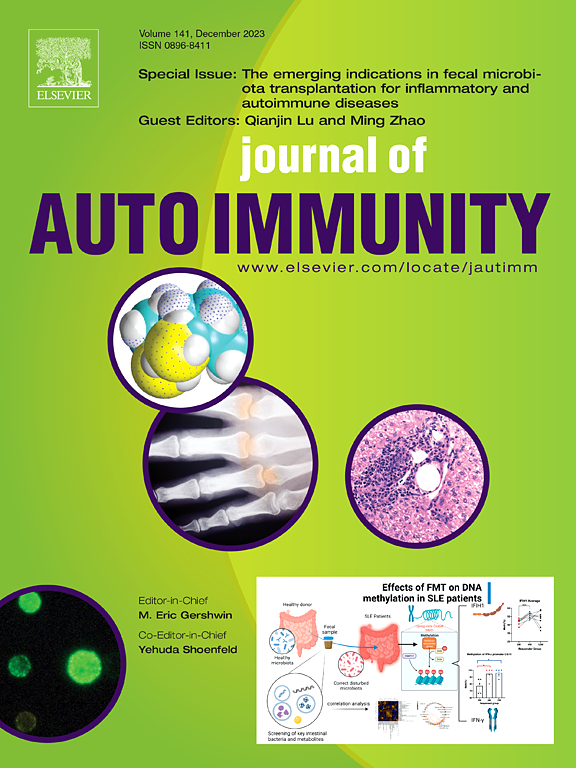童年逆境如何影响儿童免疫介导炎症性疾病的风险
IF 7
1区 医学
Q1 IMMUNOLOGY
引用次数: 0
摘要
背景:儿童发病的免疫介导炎症性疾病(pIMID)的病因尚不清楚,特别是早期生活逆境的相互作用。我们探讨了生命早期逆境是如何影响一生中出生队列中piid风险的。方法纳入1981年至2015年在丹麦出生的所有儿童。在生命最初1000天内遇到的逆境从丹麦登记处获得,并分为三个方面:生物、物质和家庭。结果是在2至18岁之间发生pIMID(自身免疫性肝病、炎症性肠病、青少年特发性关节炎、血管炎和系统性红斑狼疮)。Cox比例风险模型和加性风险模型评估了累积逆境负荷对pIMID发生的影响。机器学习模型确定了与增加的绝对风险估计相关的暴露模式。结果在2,123,827名儿童中,9070名发生了pIMID。生物逆境的累积负担与发生pIMID的高风险相关;2种逆境的aHR为1.23 (95% CI: 1.07 ~ 1.41),≥4种逆境的aHR为1.8 (95% CI: 1.4 ~ 2.2)。相反,家族逆境与风险降低相关(0.66 [95% CI: 0.41 - 1.1])。在物质维度上没有发现关联。机器学习模型确定了一种逆境模式,这种模式与人群亚组中piid风险高出五倍相关。结论生命早期生物逆境是发生piid的重要危险因素。在家庭方面观察到的较低风险出乎意料,但可能反映了社会弱势家庭的延迟诊断。这种潜在的医疗不平等需要进一步探索。本文章由计算机程序翻译,如有差异,请以英文原文为准。
How early-life adversity affects the risk of pediatric-onset immune-mediated inflammatory disease
Background
The etiology of pediatric-onset immune-mediated inflammatory disease (pIMID) is poorly understood, particularly the interplay of early-life adversities. We explored how interrelated early-life adversities affect the pIMID risk in a life-course birth cohort.
Methods
We included all children born in Denmark between 1981 and 2015. Adversities encountered during the first 1000 days of life were obtained from the Danish registries and categorized into three dimensions: biological, material, and familial. The outcome was developing pIMID (autoimmune liver disease, inflammatory bowel disease, juvenile idiopathic arthritis, vasculitis, and systemic lupus erythematosus) between ages 2 and 18. Cox proportional hazards and additive hazard model assessed the effect of the cumulative adversity load on developing pIMID. A machine learning model identified exposure patterns associated with increased absolute risk estimates.
Results
Of 2,123,827 children, 9070 developed pIMID. The cumulative burden of biological adversities was associated with higher risks of developing pIMID; aHR of two adversities was 1.23 (95 %CI: 1.07 to 1.41), aHR of ≥4 adversities was 1.8 (95 %CI: 1.4 to 2.2). Conversely, >2 familial adversities were associated with a reduced risk (0.66 [95 %CI: 0.41 to 1.1]). No associations were found in the material dimension. The machine learning model identified a pattern of adversities associated with a five-fold higher pIMID risk in a population subgroup.
Conclusion
Early-life biological adversities are important risk factors for developing pIMID. The lower risk observed in the familial dimension was unexpected but may reflect delayed diagnosis in socially vulnerable families. This potential inequality in healthcare needs further exploration.
求助全文
通过发布文献求助,成功后即可免费获取论文全文。
去求助
来源期刊

Journal of autoimmunity
医学-免疫学
CiteScore
27.90
自引率
1.60%
发文量
117
审稿时长
17 days
期刊介绍:
The Journal of Autoimmunity serves as the primary publication for research on various facets of autoimmunity. These include topics such as the mechanism of self-recognition, regulation of autoimmune responses, experimental autoimmune diseases, diagnostic tests for autoantibodies, as well as the epidemiology, pathophysiology, and treatment of autoimmune diseases. While the journal covers a wide range of subjects, it emphasizes papers exploring the genetic, molecular biology, and cellular aspects of the field.
The Journal of Translational Autoimmunity, on the other hand, is a subsidiary journal of the Journal of Autoimmunity. It focuses specifically on translating scientific discoveries in autoimmunity into clinical applications and practical solutions. By highlighting research that bridges the gap between basic science and clinical practice, the Journal of Translational Autoimmunity aims to advance the understanding and treatment of autoimmune diseases.
 求助内容:
求助内容: 应助结果提醒方式:
应助结果提醒方式:


